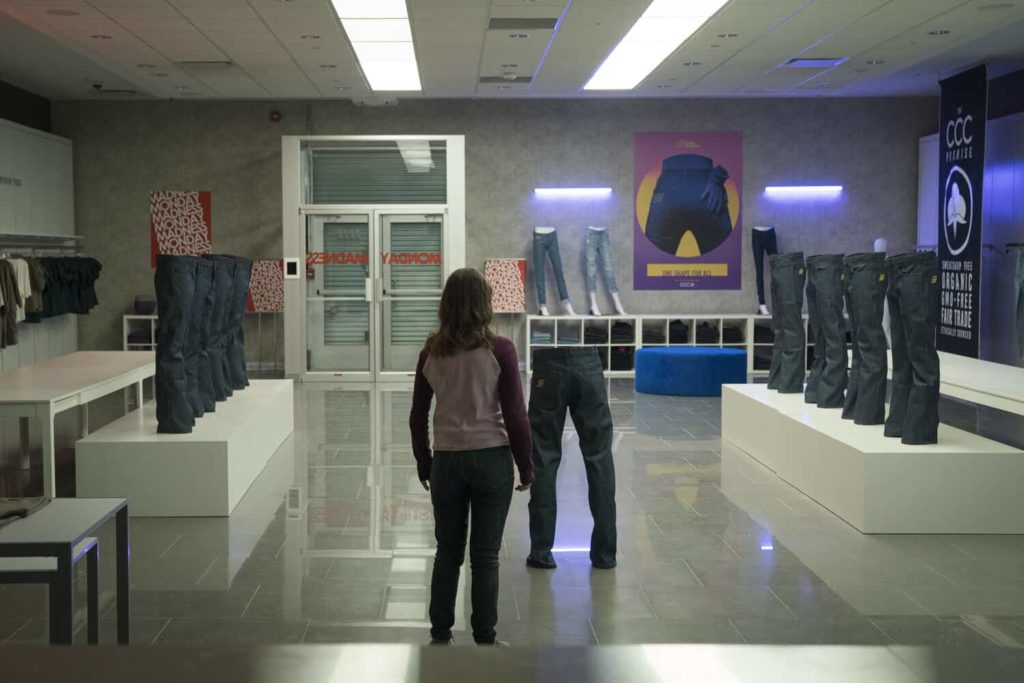
Slaxx opens with Malickian natural light and filmmaking, showing a group of Indian women harvesting cotton. The scene transitions, with the requisite ominous undertones, into a decidedly more stark aesthetic, leaving this near-Edenic scene behind for the primary colors and cold steel of “Canadian Cotton Clothiers”—the retail clothing store that serves as setting for the movie. From this opening scene, the movie sets up its throughline, an allegory of exploited farm workers and a murderous pair of denim jeans. Although there are certainly parts of the movie that work, overall, Slaxx proves to be an amateurish and blunt attempt to combine campy slaughter with political allegory.
The movie presents a cast of characters but follows our notably white final girl, Libby (played by Romane Denis), as she joins the ranks of the exalted “CCC”, which prides itself on its ethically sourced cotton and noble corporate philosophy of making the world a better place. The store is painted as a sort of Uniqlo meets Apple store, where the workers are near disciples of its wise founder, and middle managers are cutthroat in their vying for power. It’s a sleek little panopticon, with the bright colors, fluorescent cleanness, and constant surveillance part and parcel with modern retail.
With the launch of a new style of jeans coming up, Libby enters the store while its on high alert and in intensive preparation. The CEO is meant to make a visit, a famous vlogger is filming on location, and crucially, workers will be locked in the store and cut off from the internet and cell data during the launch. Unfortunately, this is when the pair of anthropomorphous denim jeans begins slaughtering people one by one, and the power-hungry store manager recruits Libby to cover up the violence.
Here and there, the movie has campy fun moments and very silly kills. The denim rips people in half, strangles them, and tends to shove their dismembered corpses into various tight spaces throughout the store. The movie proves mostly successful in its satirical takedown of the petty power plays and politics of a retail department store, which will prove familiar and sardonically clever to those well-versed in the backroom dealings of such a place. When Libby shows the middle manager (played impeccably by Brett Donahue) a dismembered coworker shoved underneath the bathroom sink, his first response is a flat “Wow, this is horrible,” and then, “I knew she was battling serious body issues, but it’s just so sad she couldn’t reach out for help,” a hilariously transparent attempt to portray the dismembered and hidden corpse as a victim of suicide to cover up any problems during the launch.

Where the movie becomes unwieldy for director Elza Kephart (who also co-wrote with Patricia Gomez) is in the attempts to tie this murderous denim to exploited foreign farm workers. The pants, it turns out, are possessed by Keerat, the farm worker from the movie’s opening, whose body was processed into the cotton due to a violent accident with the farm equipment. These moments of revelation—that the pants are possessed, that CCC is actually evil—are a little too serious for their own good. It’s not so much that such a story and character shouldn’t be taken seriously, as it is that the movie falters between campy silliness and holier-than-thou morality, without ever seeming to realize that the horrors of an exploited foreign working class aren’t explored or engaged with within the confines of the movie, satirically or otherwise. These horrors are merely exposition for the savage pants to be painted as political statement.
In trying to give voice to Keerat, the movie reduces the Indian woman to a CGI pair of denim that does an occasional Bollywood dance number. The only other Indian woman in the movie is mostly used as an intermediary translator between Keerat and Libby. Of course, this is part and parcel with the genre of horror to which Slaxx belongs: disposable characters and scant plot built around gimmicky kills. It’s rather successful on this front for the most part, but its racial politics are enough to give one pause. Slaxx‘s primary focus is Libby– an admittedly ineffectual white savior, but a white savior nonetheless– even as it attempts to say something about exploited Indian farm workers.
There is certainly something near-astute portrayed in the movie about ineffectual white saviors and their penchant for seeing the violence of a revolting working class as ethically worse than the violence of exploiting a working class. Specifically, Libby’s inability to connect with Keerat and her perhaps justified vengeance is part of the cause of Libby’s problems; that is, she ends up being her own worst enemy. Yet, the filmmaker and the movie undermine this message and the campy horror they paint over it by sidelining the only two named Indian characters into CGI, tropes, and thin characterization. It’s not that there couldn’t be a more successful version of Slaxx– perhaps one that decenters it’s protagonist or thinks more critically about casting,–it’s just that the version of Slaxx we have suffers from familiar blindspots: women of color are just tools and casualties of a white women’s story.
Slaxx
2020
dir. Elza Kephart
77 min.
Available on Shudder on Thursday, March 18
Streaming is no substitute for taking in a screening at a locally owned cinema, and right now Boston’s most beloved theaters need your help to survive. If you have the means, the Hassle strongly recommends making a donation, purchasing a gift card, or becoming a member at the Brattle Theatre, Coolidge Corner Theatre, and/or the Somerville Theatre. Keep film alive, y’all.

